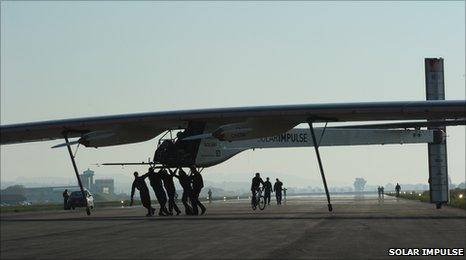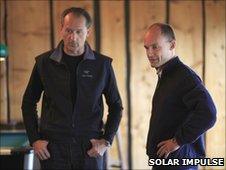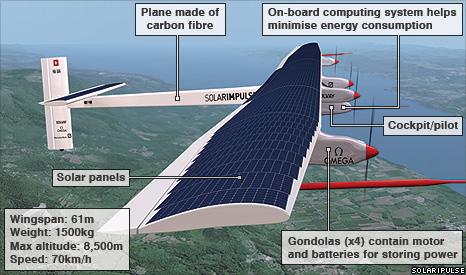Solar Impulse plane postpones record night flight bid
- Published

The HB-SIA aeroplane will eventually give way to an even bigger vehicle
Pilot Andre Borschberg has announced he is postponing an attempt to make aviation history because of a technical problem.
He had planned to take off from a Swiss airfield in a solar-powered plane and fly through the night.
The plane would need to generate enough energy through the day to sustain its battery-driven engines at night.
One of the aeroplane's inventors, Bertrand Piccard, said the pilot would have to wait for a part from the US.
'Solar future'
The HB-SIA aeroplane, which has 12,000 solar cells, is the latest step in the Solar Impulse project, which Mr Borschberg leads with his business partner and fellow adventurer, Dr Piccard.
It was to have taken off from Payerne in the west of Switzerland in an attempt to fly for 24 hours.
Robotic craft have achieved this feat before now, but never a manned one.

Borschberg (L) and Piccard have worked on the project for seven years
"We had to take the decision to postpone the take off to another day," Dr Piccard said.
Dr Piccard famously made the first non-stop circumnavigation of the globe in a balloon in 1999.
The pair want to prove that solar power has a practical future in aviation and, more generally, in powering society at large.
The HB-SIA has the look of a glider but is on the scale - in terms of its width - of a modern airliner.
The aeroplane incorporates composite materials to keep it extremely light, and uses super-efficient solar cells, batteries, motors and propellers to keep itself in the sky.
The vehicle was unveiled last year and has since been undergoing daylight trials. The first full day flight was completed on 7 April.
The HB-SIA will be succeeded by HB-SIB. It is likely to be bigger, and will incorporate a pressurised capsule and better avionics.
The group plans to use this vehicle in two years' time to make the first manned transatlantic solar flight, followed in 2013 by an even more daring circumnavigation of the Earth.

- Published15 June 2010